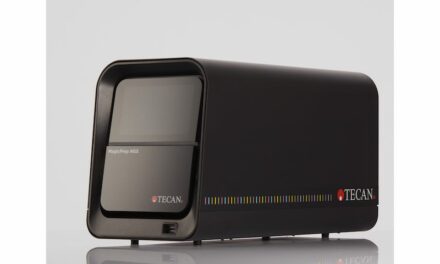Genapsys CEO Jason Myers explains how his company is planning to solve the twin dilemma facing the healthcare enterprise—return on investment (ROI) and patient access—with the company’s NGS platform .
By Chris Wolski
Return on investment (ROI) and patient access. These two, often mutually exclusive priorities for the healthcare enterprise are among the top issues facing laboratory managers and pathologists today.
In the for-profit U.S. healthcare system, diagnostic tests must be economically viable for them to be added to the laboratory menu. On the flipside they also have to be accessible to a large patient population so labs and the health systems they serve can care for as many patients as possible.
As Jason Myers, PhD, CEO of Genapsys, describes in the following Q&A, it is possible to have tests that provide ROI and are accessible to the largest patient population possible. Myers brings over 20 years of experience in the genomics industry. Prior to leading Genapsys, he was a co-founder and CEO of ArcherDX, and prior to that he led platform and sequencing application development for Ion Torrent, which was later acquired by Life Technologies.
The following Q&A has been edited for length and clarity.
CLP: Can you give me an overview of your technology?
Jason Myers: At Genapsys, we aim to unlock universal access to genomic sequencing by empowering academic and clinical researchers, molecular pathologists, and, ultimately, diagnosticians with a product ecosystem that can deliver the most accurate and actionable genomics data. The Genapsys NGS platform will be a modular and accessible benchtop electronic sequencing platform that is highly accurate, scalable, and affordable. The platform will include at its core a semiconductor chip that contains millions of sensors designed to measure minute changes in electrical signal upon incorporation of a nucleotide base. Because of its steady-state nature, the signal stays constant so multiple measurements can be taken over time, increasing precision and signal-to-noise ratio which can significantly improve accuracy. The sequencer will offer built-in throughput optionality by offering scalable consumable chips for use on the same platform, thereby eliminating the need to use different instruments for different throughput.
CLP: What will be some of the diagnostic laboratory uses for the Genapsys sequencer?
Myers: Given the emergence of circulating tumor DNA (ctDNA)-based applications in oncology, such as early cancer detection, therapy guidance, therapy selection, and minimal residual disease monitoring, this will be a focus area for Genapsys in the future. The combination of high accuracy, affordability, and scalability will make our benchtop sequencer ideally suited for diverse customer segments including academic medical centers, hospital labs, and community hospitals who want to conduct this type of analysis.
CLP: One of the things that I think is really exciting about your technology is that it plans to answer two key needs for smaller healthcare enterprises today: ROI and patient access. Can you discuss the potential of Genapsys to solve these twin and often conflicting priorities?
Myers: Genapsys looks to rapidly enable and scale the power of genomics, addressing barriers to adoption and [patient] access, particularly within smaller labs, so every researcher, physician, provider, and patient has access to sequencing technology insights. We believe that to make accessibility affordable, the platform must fundamentally differ from what is available today. Our unique approach, a semiconductor, chip-based electronic sequencer, differs from other pH-based or optical-based technologies that utilize optics, fluorescent tags, high-power lasers, cameras, scanners, and other complex devices. Therefore, we can not only create a substantial reduction in capital cost, but the simplicity of the detection modality will yield the return of an affordable instrument with an economical cost per test across multiple applications. Additionally, we are planning for flexibility and scalability with access to different versions of the semiconductor chip, which, in turn, will provide throughput options that span multiple orders of magnitude, further enabling random access. A benchtop device paired with the ability to scale testing up or down through the utilization of different sequencing chips will provide smaller labs with access to an in-house cost-effective sequencing platform. The more decentralized testing that is done the less dependent an organization is for send-outs, which layers more cost savings, but most importantly brings us all one step closer to universal access to genomic testing. Universal access will deliver an ROI on its own. Our low-cost sequencer combined with tunable output will enable a streamlined operational workflow where our users are no longer in a position of needing to choose between turnaround time and per-sample sequencing cost. Moreover, our instrument cost is expected to be less than the typical annual service cost for some of the existing platforms in the market. We believe that the significantly lower cost of ownership will also allow our users to scale with increased demand.
CLP: I want to dive a little more into the patient access side of the equation—how will having more patient access to advanced sequencing technology be a benefit for clinical laboratories, particularly small labs without the resources or maybe volume of their larger cousins?
Myers: Fast, affordable, and accurate sequencing technology is a key component for driving advancements in precision medicine. Clinicians use sequencing information to inspect the genome and identify patterns from patients to select optimal treatment options for the individual and more so—to develop new personalized treatments based on the resulting knowledge. When costs are reduced, many more labs and companies have access to DNA sequencing. More clinicians and academics will be able to investigate and understand genetic patterns in disease to prompt more discoveries and potential treatment options. Take for example, the ability to streamline the analysis of a cancerous tumor. When sequencing is scalable and more affordable, smaller clinics can conduct repeated genomic sequencing and track tumor mutations. Being able to conduct the sample-to-results workflow in-house will allow doctors, scientists, and academics to better guide treatment options for patients at a greater speed. They also have the information more readily available to understand when cancer cells have become resistant to certain drugs, for instance.
CLP: I know another thing that you’re looking at is keeping the technology simple and small. Why should this also be a priority?
Myers: There is a great need for affordable sequencing options that produce accurate data among small and mid-size labs that do not have the infrastructure, expertise, and budget for large-scale sequencers, which can be large, expensive, and require a high volume of samples to be cost-effective. Small and medium-sized laboratories have a real need for low-cost sequencers. At present, many smaller labs either don’t use sequencing or they are forced to outsource it, meaning they must deal with rigid sample batching on large instruments run in central service labs, which ultimately results in higher costs and long turnaround times. It can be difficult to get all these different parts to work together seamlessly. The Genapsys instrument will be a benchtop sequencer that will enable decentralization and distributed sequencing in an unprecedented way driven by the ability to swap different semiconductor chips with scalable detectors on one affordable benchtop instrument. Because of this, users will be able to perform their sequencing on-site, enabling easy and rapid access to actionable insights based on genomic data. This will lead to labs being one step closer to making genomic analysis the standard of care, enabling easier and less costly detection, monitoring and management of diseases and the ability to link genetic variations with health and illness.
CLP: Is the Genapsys instrument available now? If not, when do you expect it to be launched?
Myers: Genapsys continues to develop our technology and will launch our updated product in the near future. Labs will be able to utilize the product for a range of applications such as targeted, small genome and RNA sequencing, as well as clinical research applications such as liquid biopsy ctDNA testing related to oncology. With our scalable and accurate solution, we are excited to transform the future of sequencing and enable thousands of laboratories and researchers to better understand cancer and other diseases.
CLP: What do you see as the future of genetic sequencing? How will labs change in light of the advances in speed, patient access, and reductions in costs?
Myers: As more academic and clinical researchers look to understand cancers and other life-threatening diseases, we anticipate that labs of all sizes will want to be part of research efforts to help with the discovery of mechanisms, diagnosis, and treatment of disease. Labs will continue to seek affordable, accurate, and accessible sequencing options that help them obtain genomic data and testing results in a timely manner while maximizing their return on investment. There are a large number of research labs interested in the world of genomics, but only a small number that can afford to acquire and run these platforms in their own labs. Sequencing companies who recognize this need will look to make technology more accessible so that academic and clinical researchers who previously lacked access to sequencing can accelerate their research and discoveries with genomics data. A platform like Genapsys will enable and advance the genomic revolution, and we anticipate some groundbreaking discoveries in the next several years when researchers will be empowered and able to use platforms like ours.
Chris Wolski is chief editor of CLP.





